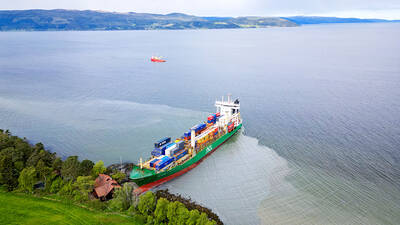Museum authorities at the former Nazi Auschwitz-Birkenau death camp in Poland are struggling to save the enduring symbol of the Holocaust from the impact of time and the elements.
In the drive to stop the site falling into ruin and preserve the memory of the 1.1 million overwhelmingly Jewish victims who died here during World War II, they face tall odds.
“This is our last chance,” said Piotr Cywinski, director of the state-run museum.
The museum keeps going thanks to the Polish government, which covers around half of its costs, plus visitors’ ticket fees. Up to 5 percent of its budget comes from the US-based Lauder Foundation and Germany’s regional governments.
Last month it announced plans for a 120 million euro (US$163 million) appeal to enable it to become self-financing.
Crucially, said Cywinski, it could then set aside some 5 million euros a year for conservation work.
The rudimentary buildings of the camp’s Birkenau site, built by the prisoners on marshy land, are being battered by soil erosion and water damage.
“We have to finish conservation work on all these buildings within 10 to 12 years, so we need to start within three years at the latest,” Cywinski said.
“The primary goal is to preserve the site’s authentic nature and not to rebuild it, in order not to change the perception of this place,” he added.
“But the big question today is: Do we want to save this place?” he said.
Preserving a single barrack-block costs around 880,000 euros, conservation chief Rafal Pioro said.
Warsaw has called on the international community to support the new drive to maintain the camp.
The museum site covers 191 hectares, with 155 buildings and 300 ruins, and has a collection of thousands of personal items, as well as documents exposing the minutiae of the Nazis’ killing machine.
The Nazis initially set up the camp for Polish resistance fighters, nine months after invading Poland in September 1939.
The original camp was at a former Polish army barracks on the edge of the southern town of Oswiecim — known in German as Auschwitz.
Two years later the Nazis greatly expanded the site at nearby Brzezinka, or Birkenau.
Around 1.1 million people died at Auschwitz-Birkenau between 1940 and 1945 — 1 million of them Jews from Poland and elsewhere in Nazi-occupied Europe — some from overwork, starvation and disease, but most in the notorious gas chambers.
It was one of six death camps set up in Poland — home to pre-war Europe’s largest Jewish community — by the occupying Germans, who murdered 6 million Jews during the war.
Non-Jewish Poles, Roma and Soviet POWs were also among the many victims of Auschwitz-Birkenau and the other death camps found in Chelmno, Treblinka, Sobibor, Majdanek and Belzec.
The museum devotes much of its time to protecting the intimate traces of the prisoners’ presence.
Each of the 80,000 shoes stockpiled by the Nazis, for example, is being painstakingly preserved.
“There’s no technical problem to bring back the original beauty of an old shoe, but that would wipe away its entire story,” Cywinski said.
The task of the museum’s laboratories, financed by the Lauder Foundation, is unique.
“There are ways to restore medieval objects, but not to conserve six-decade-old, poor quality plastic toothbrushes ... We don’t have any reference point,” Cywinski said.
Researchers have identified 90 different kinds of ink or pencil on the 40,000 documents left by the Nazi medical service.
Each document with different ink or pencil requires a different conservation method, expert Nel Jastrzebiowska said.
The museum, set up by the Polish government in 1947, last year drew 1.13 million visitors compared to half that in 2001 — crucial for remembrance, but putting extra physical pressure on the site.

BACKLASH: The National Party quit its decades-long partnership with the Liberal Party after their election loss to center-left Labor, which won a historic third term Australia’s National Party has split from its conservative coalition partner of more than 60 years, the Liberal Party, citing policy differences over renewable energy and after a resounding loss at a national election this month. “Its time to have a break,” Nationals leader David Littleproud told reporters yesterday. The split shows the pressure on Australia’s conservative parties after Prime Minister Anthony Albanese’s center-left Labor party won a historic second term in the May 3 election, powered by a voter backlash against US President Donald Trump’s policies. Under the long-standing partnership in state and federal politics, the Liberal and National coalition had shared power

NO EXCUSES: Marcos said his administration was acting on voters’ demands, but an academic said the move was emotionally motivated after a poor midterm showing Philippine President Ferdinand Marcos Jr yesterday sought the resignation of all his Cabinet secretaries, in a move seen as an attempt to reset the political agenda and assert his authority over the second half of his single six-year term. The order came after the president’s allies failed to win a majority of Senate seats contested in the 12 polls on Monday last week, leaving Marcos facing a divided political and legislative landscape that could thwart his attempts to have an ally succeed him in 2028. “He’s talking to the people, trying to salvage whatever political capital he has left. I think it’s

CONTROVERSY: During the performance of Israel’s entrant Yuval Raphael’s song ‘New Day Will Rise,’ loud whistles were heard and two people tried to get on stage Austria’s JJ yesterday won the Eurovision Song Contest, with his operatic song Wasted Love triumphing at the world’s biggest live music television event. After votes from national juries around Europe and viewers from across the continent and beyond, JJ gave Austria its first victory since bearded drag performer Conchita Wurst’s 2014 triumph. After the nail-biting drama as the votes were revealed running into yesterday morning, Austria finished with 436 points, ahead of Israel — whose participation drew protests — on 357 and Estonia on 356. “Thank you to you, Europe, for making my dreams come true,” 24-year-old countertenor JJ, whose

UNSCHEDULED VISIT: ‘It’s a very bulky new neighbor, but it will soon go away,’ said Johan Helberg of the 135m container ship that run aground near his house A man in Norway awoke early on Thursday to discover a huge container ship had run aground a stone’s throw from his fjord-side house — and he had slept through the commotion. For an as-yet unknown reason, the 135m NCL Salten sailed up onto shore just meters from Johan Helberg’s house in a fjord near Trondheim in central Norway. Helberg only discovered the unexpected visitor when a panicked neighbor who had rung his doorbell repeatedly to no avail gave up and called him on the phone. “The doorbell rang at a time of day when I don’t like to open,” Helberg told television